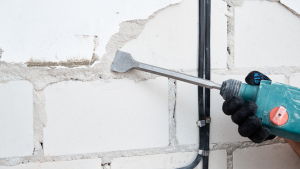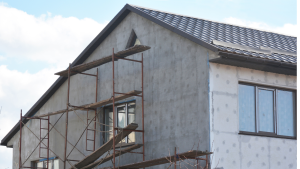of stucco homes constructed between the 2000s and the middle of 2010. Inadequately created stucco systems may result in costly and dangerous water damage.
When water seeps through your walls, your home’s structural integrity may be in danger, and health hazards might result. This makes determining if water has been trapped in your walls essential. You should immediately engage a stucco remediation professional if water is in your walls.
It’s best if your damaged home can be fixed as quickly as possible. Water damage worsens with time, driving up the cost of cleaning.
You should know the seven signs that your stucco has water damage. Symptoms of water damage to stucco include bubbling, cracking, softening, staining, moss growth, and mold growth.
1. Crack Formation
Not all cracks mean that water has damaged your stucco. They could not even be a sign of damage. Stucco cracks may result from a number of things, such as the foundation of your house sinking.
Naturally, this does not mean that any cracks in your stucco that you see should be ignored. If it did, they wouldn’t be on this list. However, if you see cracks enlarging, you should look for further signs of water damage.
Damage may have occurred if there are hairline fractures. If no more symptoms are found, you may be able to leave the cracks alone or conceal them. Larger fractures are the main issue. They could result from the moisture buildup that causes your stucco to expand and contract.
Additionally, even if the more extensive break doesn’t exhibit any other signs of water damage, you must fix it. Even while the crack may not have been caused by water, it might let water into your walls and harm them.
2. Staining
The presence of stains on your walls is a clear sign that dampness is affecting them. You might notice dirty streaks when water flows, such as from the corners of your windows. In this instance, there can be an issue with the installation or flashing.
Black patches may sometimes be noticed in addition to streaks. These discolored spots can be due to moisture trapped within the wall. Painting over the discoloration won’t help since it is the consequence of a more severe problem.
Your stucco walls may seem damp in the discolored area. If it occurs just after a thunderstorm, it needn’t worry you. However, if the regions that look damp persist, it might be an issue. The proximity of cracks is an excellent spot to start looking for dark patches while searching for them since here is where water may be entering the wall.
3.Moss Growth
Moss does not necessarily indicate that water has leaked into your walls and is causing damage. However, it shows that water needs to be directed more away from your walls. Water may ultimately harm your walls if not correctly handled away from them.
Moss often grows at the bottom of walls and where water runs down them. If water flows down your walls, your gutters or flashing may be broken. Additionally, if moss is developing at the base of your walls, there could not be sufficient room between the wall’s termination and the ground.
It’s time for repairs if you see moss growing on your stucco or other siding.
4.Mold Growth
Instead of moss, mold development often signals that water is trapped within your walls. Mold prefers dark, damp conditions, like those found behind wet walls. If you see black spots on your stucco, mold can be present. Even though there is mold on the outside, your walls have more mold.
Mold is harmful for two main reasons. First of all, it may be detrimental to your health. The mold in your walls might endanger the people who reside in your home. The second sign is likely the deterioration of the wooden timbers within your walls. As the beams deteriorate, your walls’ structural integrity declines.
5. Surface Crumbling
If it is, the surface of your crumbling stucco should be rather evident. Although surface degradation is not always caused by water, it is often a sign of underlying deterioration. But it’s a signal that something needs to be corrected within your walls.
As the wall’s surface deteriorates, your walls are more vulnerable to damage—additional damage results in removing additional layers. And the damage grows as other layers disintegrate. Your home sustains ongoing damage as a consequence.
You may determine if water damage is the root of the cracking by feeling the newly exposed layers for dampness or mush.
Another problem with surface cracking is that fewer layers protect your property from water. Since stucco is a porous substance, water will unavoidably travel through it. However, you don’t want to allow in so much water that it can’t be efficiently be expelled from the walls.
6. Soft Spots
Soft spots on your stucco often go along with other signs of water damage. If your walls contain moss or mold, they will have weak areas. If there is staining, it usually occurs on a smooth surface.
However, if you see fractures or other damage that wasn’t necessarily caused by water, you should inspect the area for soft spots. If you find them, you have probably found the criminal.
7. Surface Bubbling
Bubbles are a sign of water damage, and they often occur together with mushy areas and cracks. It occurs when hot moisture escapes under or between your stucco’s layers. Bubbles are often seen at the bottom of walls where water gathers.
CMB Jersey City Stucco & EIFS Repair Remediation
Whenever there are indications of water damage to your stucco building, contact CMB Jersey City Stucco & EIFS Repair. After checking your walls at home, we’ll let you know what to do next.




